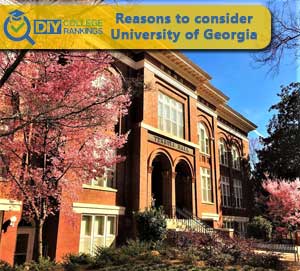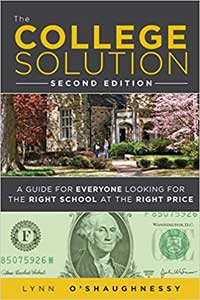
University of Georgia -Public
Athens, Georgia
37,606 (28,848 undergraduates)
Does College Size Matter?

Athens, Georgia
37,606 (28,848 undergraduates)
Does College Size Matter?
 If you only get one book for your college search, get The College Solution: A Guide for Everyone Looking for the Right School at the Right Price by Lynn O’Shaughnessy. Why? You mean because I said so isn’t enough?
If you only get one book for your college search, get The College Solution: A Guide for Everyone Looking for the Right School at the Right Price by Lynn O’Shaughnessy. Why? You mean because I said so isn’t enough?
Okay, here’s the deal about buying a book about a subject you don’t know much about. If your knowledge approaches zero then any book you buy will provide you with dramatically more information than you had and will be useful. But that doesn’t mean you are getting all the information you need.
 Once you get past making sure a college has your potential major, there are all kinds of ways of distinguishing colleges from each other besides college rankings. There are the obvious ones such as cost, rural versus urban, size, and location. But there are some that can significantly affect a student’s college experience that many have never heard of, much less considered. One of them is the 4-1-4 academic calendar.
Once you get past making sure a college has your potential major, there are all kinds of ways of distinguishing colleges from each other besides college rankings. There are the obvious ones such as cost, rural versus urban, size, and location. But there are some that can significantly affect a student’s college experience that many have never heard of, much less considered. One of them is the 4-1-4 academic calendar.
The what calendar?
 Families that can’t afford to pay the sticker-price for private colleges need to do two things. The first is identify which schools are more likely to provide need or merit aid. The second is avoid those that are less likely to do so. This means steering clear of “dream” schools that may rank in terms of prestige but subsequently aren’t as generous with financial aid as some of their peers.
Families that can’t afford to pay the sticker-price for private colleges need to do two things. The first is identify which schools are more likely to provide need or merit aid. The second is avoid those that are less likely to do so. This means steering clear of “dream” schools that may rank in terms of prestige but subsequently aren’t as generous with financial aid as some of their peers.

Altoona, Pennsylvania
3,482 (all undergraduates)
Does College Size Matter?
 The NCAA Division 2 is the smallest of the three NCAA Divisions. Division 2 colleges, like Division 1 schools, offer athletic scholarships. However, they do not offer as many scholarships in many sports and are not required to sponsor as many varsity teams as D1 programs. They also tend to offer more partial scholarships. However, since they aren’t required to offer headcount scholarships, you will often find D2 colleges actually sponsor more varsity teams than required.
The NCAA Division 2 is the smallest of the three NCAA Divisions. Division 2 colleges, like Division 1 schools, offer athletic scholarships. However, they do not offer as many scholarships in many sports and are not required to sponsor as many varsity teams as D1 programs. They also tend to offer more partial scholarships. However, since they aren’t required to offer headcount scholarships, you will often find D2 colleges actually sponsor more varsity teams than required.
 When creating their preferred list of colleges, many students are looking for schools that will include the “big city” experience. New York is the obvious choice. However, students shouldn’t overlook the nation’s 7th largest city, Philadelphia, just a 90 minute train ride to the south. Surely it can provide the requested “big city” experience at one of its 35 area colleges and universities. Furthermore, 16 colleges in Philadelphia have at least a 50% graduation rate while accepting at least 50% of applicants qualifying them as 50-50 schools.
When creating their preferred list of colleges, many students are looking for schools that will include the “big city” experience. New York is the obvious choice. However, students shouldn’t overlook the nation’s 7th largest city, Philadelphia, just a 90 minute train ride to the south. Surely it can provide the requested “big city” experience at one of its 35 area colleges and universities. Furthermore, 16 colleges in Philadelphia have at least a 50% graduation rate while accepting at least 50% of applicants qualifying them as 50-50 schools.
 I’m pretty sure the number of students who would want to attend college close to beaches and mountains and with sunny weather outnumbers those that don’t which is why many look for colleges in Los Angeles. With the area’s entertainment industry, international business connections, and tech development, Los Angeles has more than just its climate and geography to appeal to students. Maybe that’s why there are 49 colleges in the greater Los Angeles area (Combined Statistical Area) with 14 of them accepting at least 50% of students while having at least a 50% graduation rate qualifying them as 50-50 schools.
I’m pretty sure the number of students who would want to attend college close to beaches and mountains and with sunny weather outnumbers those that don’t which is why many look for colleges in Los Angeles. With the area’s entertainment industry, international business connections, and tech development, Los Angeles has more than just its climate and geography to appeal to students. Maybe that’s why there are 49 colleges in the greater Los Angeles area (Combined Statistical Area) with 14 of them accepting at least 50% of students while having at least a 50% graduation rate qualifying them as 50-50 schools.
 Going to college in Boston isn’t just for high school valedictorians, those with 10 AP classes on their transcripts, or those with test scores in the 90th percentile or higher. It’s only natural that you would assume so with names like Harvard, MIT, Tufts, Boston College, Wellesley, Northeastern, and Brandies dominating the higher education neighborhood. However, learning really is for everyone and there are 36 colleges in the greater Boston area with 500 or more full-time undergraduates. You do the math. Furthermore, a third of them are 50-50 colleges.
Going to college in Boston isn’t just for high school valedictorians, those with 10 AP classes on their transcripts, or those with test scores in the 90th percentile or higher. It’s only natural that you would assume so with names like Harvard, MIT, Tufts, Boston College, Wellesley, Northeastern, and Brandies dominating the higher education neighborhood. However, learning really is for everyone and there are 36 colleges in the greater Boston area with 500 or more full-time undergraduates. You do the math. Furthermore, a third of them are 50-50 colleges.